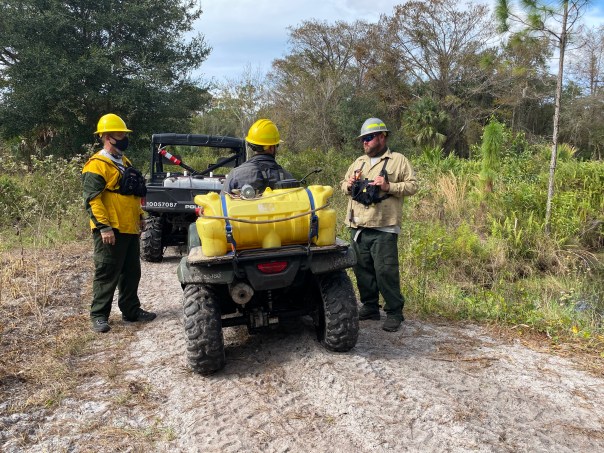 Born in the 1960s, I am a child of the Smokey Bear generation taught -at all costs- to avoid forest fires. Times have changed and we now know that fire is a necessary part of Florida’s ecology bringing renewal. As a Governing Board member of the South Florida Water Management District, I decided before 2020 ended, I should learn about this first hand.
Born in the 1960s, I am a child of the Smokey Bear generation taught -at all costs- to avoid forest fires. Times have changed and we now know that fire is a necessary part of Florida’s ecology bringing renewal. As a Governing Board member of the South Florida Water Management District, I decided before 2020 ended, I should learn about this first hand.
Recently, Section Leader, Jim Schuette, Land Management Department, was my guide. We met near Cypress Creek in Palm Beach County near the Loxahatchee. We arrived early and were greeted by a small herd of adorable Zebu cattle – like miniature Cracker Cattle!
Shortly thereafter, Gene Colwell, Senior Scientist, and Land Management Techs, Hal Camp and Marshall Davis arrived. Gene led the detailed safety/info briefing. “I hope I can do this,” I thought. Jim gave me some fireproof clothing and a hard hat. Suddenly, I was just “one of the guys.”
-Senior Scientist, Gene Caldwell leads briefing -Loxahatchee River Area near border of Martin & Palm Beach counties
-Loxahatchee River Area near border of Martin & Palm Beach counties

 The fires were set with cans of diesel and gas and I noticed the pine needles that carpeted the forest burned slowly first. I was concerned about the wildlife.
The fires were set with cans of diesel and gas and I noticed the pine needles that carpeted the forest burned slowly first. I was concerned about the wildlife.
“When the animals smell this they leave the area,” Jim said.
“Are there any gopher holes for the smaller animals to hide in?” I inquired.
“Yes, and the ground is moist.” He placed a handful of soil into my hand and explained that due to time of year and wet conditions, it would not be a towering fire. Jim noted that the team always worked to protect the canopy of the pine trees. I knew that in spite of the best circumstances, sometimes, there must be casualties, but for the health of the forest over-all it’s beneficial.
Stepping away from the heat, I read my UF handout:” Ecological research shows that fire is an integral component in the function of natural habitats and that the organisms within these communities have adapted to withstand, and benefit from wildfires. In fact, many Florida habitats only exist due to the presence of wildfires. Some were created by frequent fires, others by a few big fires decades apart.”
As time went on things heated up; I watched as Marshall and Hal used fire guns that ignited diesel filled ping-pong balls that were shot into the woods. Later in the day, I was asked if I wanted to participate under the supervision of the team.
Getting my nerve up, I grabbed one of the heavy fire-lighting containers.
Mr Calwell instructed me to start the fires a good distance apart along the edge of the forest. The pine needles ignited first, cracking and moving like a living organism all its own. It felt strange lighting the woods on fire.
“There were a lot of things we believed in the 1960s that we no longer hold true.” I thought to myself.
The can was heavy and I used both arms. My neck ached. The sound of the fires popped and cracked as tall tongues hissed in the oily palmettos. Suddenly, liquid like flames traversed the bark of the pine trees creating a windstorm of fiery renewal. I was told the new growth would start coming back within just two days…


-Hal Camp with fire gun -Jim Schuette reports smoke situation on 1-95 “visibility is good”
-Jim Schuette reports smoke situation on 1-95 “visibility is good”
 -Palmettos and sable palms are oily and burn quickly
-Palmettos and sable palms are oily and burn quickly 
 -Post burn using water to cool hot spots
-Post burn using water to cool hot spots


 -Fire brings renewal. Within just days green sprouts will emerge! Above Jim wets embers
-Fire brings renewal. Within just days green sprouts will emerge! Above Jim wets embers
FIRE VIDEOS: IMG_7289
Thank you to Jim Schuette and the SFWMD Land Management team for this experience!